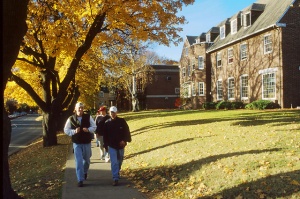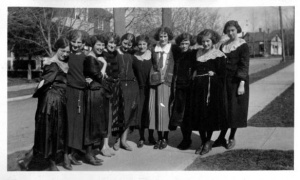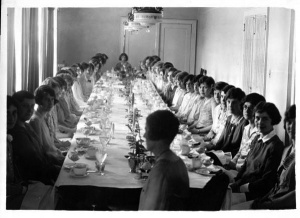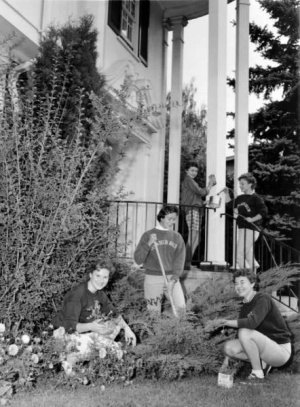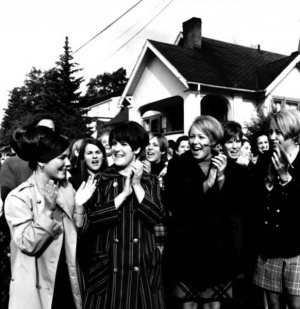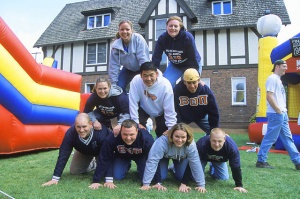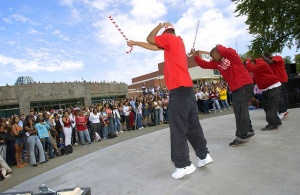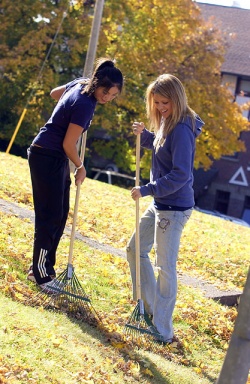Personal tools
Help
Tools
Class Notes
- Do you have news for fellow WSU alumni and other readers of Washington State Magazine? Send us your class note.
Our Story
written by alumni, faculty and friends.
NOTE: THIS IS A LEGACY SITE AND IS NOT REGULARLY MAINTAINED
Views
A Century of Greek Life at WSU
From Our Story
A brief history of the Greek community at Washington State University
from Center for Fraternity and Sorority Life
What would eventually become Washington State University was founded in 1890 when the state legislature established the land-grant college. The first Board of Regents met that April to begin the work of making a college. George Lilley was appointed as first president in April, 1891. Contracts soon went out for the first few buildings. On January 13, 1892, the Washington Agricultural College and School of Science opened its doors for instruction. Photographs of the campus then do not show lots of trees and grass, but rather lots of open space and dirt. Students, mostly kids fresh from the farm, walked from the Pullman train depot up the hill to start lives different from what their parents knew. Even after Ferry Hall opened in 1892, students sought accommodation in the houses near campus—on College Hill. Spare rooms were rented and boarding houses became gathering places after class.E.A. Bryan became the third president on July 22, 1893. Instruction in Veterinary Medicine began in 1895. The first graduating class, all seven of them, received their degrees in 1887.
Contents
The First Decade of Greek Life
This first decade of the new century began with new campus buildings and more degree offerings. But the feel of the college was very much that of a small school. The president of the university, E.A. Bryan, gathered all of the students each morning for a talk. At a time when other universities observed a strict separation of students and professors, here they went on wagon rides together. How much the isolation of Pullman brought everyone together can be debated, but not ignored.
Isolation did have one very positive effect on students at the State College of Washington. Since there were not very many students, but much to do between athletics, politics, and activities, people who might have been excluded from participation in more densely populated places were accepted at the state college. Even women. Daisey T. Busby became editor of the campus newspaper in 1904 and supervised a staff of men. Women graduated with science degrees and served on campus committees, but would not take other prominent positions on campus until the 1940’s.
One amazing fact that brought students from everywhere to Pullman was that it was tuition-free. Women and farm kids and children of parents who never expected to go to college could come here and get a quality education.
It is easy to see how a like-minded group of young men found each other and common purpose in founding Kappa Theta, and with the help of the Idaho Chapter of Kappa Sigma, gained their charter as Gamma Mu of Kappa Sigma in February of 1909. The local Ophite fraternity, started in 1906, was on it’s way to becoming the Delta Iota chapter of Sigma Nu. Their charter was granted in March of 1910.
1910-1919
As enrollments increased, more Greek chapters were established and took up residence on Greek Row. Many local clubs chartered as chapters of national fraternities—like the Tolo Club becoming a chapter of Lambda Chi Alpha and the Ophites becoming Sigma Nu. Chapters took up residence in old family homes on Colorado and Linden streets, like the Walter Davis house given to Kappa Sigma.Women’s groups, still called fraternities at this time, arrived on the scene. Pi Delta Phi formed in 1906 and chartered as Alpha Sigma chapter of Kappa Alpha Theta in 1913. Two other locals became nationally chartered in 1912--local Phi Alpha Epsilon became the Beta chapter of Pi Beta Phi on July 6, 1912 and Theta Kappa local became Upsilon chapter of Alpha Delta Pi on October 5, 1912.
Even then, students had to be persuaded to leave the relative comfort of the dorms for life in chapter houses that might have not been the most luxurious of accommodations. But they were persuaded and membership blossomed. Chapter houses took on more of the feel of homes than dormitories ever could. Greek Row was the center of campus social life. And membership might even help you find a job to pay for college. Many students worked in chapter dining halls and a fellow member might have a connection to someone who might give you a job downtown. Of course, the fissure between Greeks and the rest of campus grew.
The Twenties
Expansion continued on Greek Row. As you can see from the timeline on the facing page, sixteen national chartered fraternities and sororities were operating on campus by the end of this decade. These chapters grew out of locally established clubs. Most bought or built homes on California, Colorado, Linden or Ruby streets. (The reader is referred to E.A. Bryan’s Historical Sketch of the State College of Washington for addresses of these original homes.) As more students became affiliated with these fraternities and sororities, the voting power of Greeks became apparent. Here was a large and growing groups of students who were in touch with each other and involved with campus issues. The cohesiveness of this community far surpassed that of independent students. Mobilizing them to vote turned out to be relatively easy. When leadership was needed, Tau Nu Epsilon stepped in to fill the void.Tau Nu Epsilon (TNE) at WSC formed in about 1912 or 1913 but didn’t become a power broker in student government until 1920. This was a nationwide, if unofficial, secret organization that had a profound influence on campus politics into the 1920’s. TNE provided a way for fraternities to band together and unite the voting students to elect student body presidents, editors of the Daily Evergreen, and even Homecoming Queens. Members were hand-picked by other members and most people on campus knew nothing of the organization or who it’s members were. Through its leadership, Greek Row dominated campus politics for over a decade.
Edward R. Murrow, 1926-1930, was a member Kappa Sigma at WSC. He honed his speaking skills through classes and debates, and graduated to become one our most famous alumni.
The Thirties
Student life in the 1920’s and 30’s was dominated by the influence of Dean of Women, Annie M. Fertig. She was considered a tyrant by students of the day. Lambda Chi Alpha held a dance without her approval and was placed on social restriction for the rest of the year. Many rules, like women could not wear red dresses, either issued from the Dean’s office or everyone thought they did. Dean Annie did not write her rules down. This became the chief complaint that lead to the student strike in April of 1936.
The strike was organized in about four days, something made easier by communication on Greek Row. Discussion began there and reached out to dormitories over the weekend. News was provided to the Spokane and Seattle newspapers. An estimated 3,000 to 3,500 students (nearly the entire student body) marched on Bryan Hall on May 5. Jerry Sage and Robert Yothers, along with half a dozen other students, met with President Holland for several hours to discuss the complaints.
When a disheartened Holland finally agreed to the student’s demands, it was too late on the night of May 6 to call off the strike. On the morning of May 7, pickets went up in front of all campus buildings and were honored by most students. By 4:30 that afternoon, word of the president’s concession was transmitted to students and the strike ended. Dean Annie Fertig and Dean of Men Carl Morrow resigned immediately after the strike. Rules governing student social life were soon published and a committee was established that provided fairer hearings for students. Discontent with the administration’s rules will be a recurring theme in the future.
Only three chapters were chartered in this decade, a marked slowdown from the roaring expansion during the Twenties. But clearly, as the stike organizers knew, Greek Row was still the center of student organization.
The Forties
The insulation of endless wheat fields was not enough to keep the world events away from WSC. The lasting effects of World War II reshaped campus life. After Pearl Harbor, most men joined the military and left campus. Men did come to Pullman, but as squads of trainees who only stayed four months. The task of carrying on campus traditions was left to women. For the first time, women became campus leaders, editors of the Evergreen, and set the tone for campus life.
After the war, veterans using the GI bill flooded onto campus. Enrollment in 1939 was 4,300. By 1947 it soared to 6,700. Temporary dorms were built to accommodate the new students. The fact that these men were older and had experienced military life meant that the typical treatment of freshmen by seniors would not hold. Any vestiges of the old “hacking” and other forms of hazing died away quickly. Alcohol became a much more common part of student life. Many veterans came to campus with their wives and children. Most professors at the time felt that these men were some of the serious students they had known.
The Fifties
But what brought the outside world to isolated Pullman in the biggest way might have been Rock and Roll music. The sing-alongs beside the parlor piano gave way to records and radios and a sound with urban roots. It became the soundtrack of the Korean War and the McCarthy era.
Fraternities and sororities were still a vital part of student life. In many ways, they were havens and bastions of a more conservative way of life. Amidst the rock and roll, house moms ruled and curfews were taken seriously, especially by women. Even so, woman’s place in society was quietly starting to shift—a move that would become more pronounced in the 60’s and 70’s. Alpha Phi’s were in at the beginning of it. While they built their new chapter house in 1955, they lived in one of the dormitories set up for returning GI’s. Men and women living in such proximity brought about discussions of integration—of gender, not race.
The Sixties
Vietnam War, race riots, footage from campus protests were seen on television nightly news broadcasts—the world was crashing in on Pullman’s isolation. Campus protest marches and rallies coincided with high ROTC enrollment. Anti-war and pro-war editorials sometimes appeared side by side in the Evergreen. Racial tensions ran high on campus and protests melded racial issues with nonunion migrant worker issues and included those protesting the draft.
The influence of Greek Row on campus culture waned. Rule-bound fraternities and sororities were seen as a social liability in the free-wheeling 60’s. No one really wanted to be told what to do. And the idea of coming to school to find a husband was history! Fraternities, especially, still offered the hope of making business connections that would lead to a prosperous future. In a time of chaos and shifting causes, Greek chapters held steady. Alpha Chi Omega built a new chapter house during the sixties, and moved out of the building that is now known as the K House.
The Seventies
Rogers Stadium burned April 4, 1970—attributed to arsonists but no one was ever charged. Agitation on campus reflected the agitation of the day. The killing of students on another college campus mobilized student anger at WSU. After a meeting with student leaders, President Terrell sent a telegram to President Nixon stating that the shooting at Kent State and the Cambodian invasion had “outrage and dismay on the part of a substantial segment of the campus at Washington State University.”As more students of color came to campus, racism followed them. Several incidents prompted the call of black students for action. Graduation in 1970 brought an end to the student strike against racism on campus. One result of the strike was the Racism Workshop held as students came back to school in the fall of 1970. This workshop gave an opportunity for students on both sides of the divide to learn about each other.
As the decade progressed, the radicalism of the sixties faded and traditions that had been left behind returned to popularity. Gradually, protest marches become more everyday occurrences than shocking calls to action. The tumult and social consciousness of the sixties gave way to more laid-back, pleasure centered campus climate. By the half-way point of the decade, fraternities and sororities were again recruiting more members than their houses could hold. The Coug went back to being a tavern in 1976 and a favorite haunt of those living on Greek Row. Keggers were not uncommon and “The Wheel,” during which groups of sorority women rotated through fraternity parties, was a back-to-school ritual.
The Eighties
The challenging issue of the 1980’s and the administration of President Sam Smith was alcohol. While the seventies had been a time for keggers and open parties, the administration cracked down on alcohol use in the eighties—with Greek Row being a target. Legal liability became everyone’s concern. Matters came to a head in 1987 when key administrators ordered the disbanding of the IFC Executive Committee after a very raucous party shortly before the start of the school year. Because of the summary nature of the order, non-Greek students rallied to the cause. Just when it looked like another protest march or strike was in the offing, fraternity leaders met with administration officials and together drafted an alcohol-use policy.
All campus activities declined as students focused on their resumes and eventual careers. What had been an outward focus during the fifties and sixties had turned inward. The traditional formal homecoming dance went the way of the frosh beanie. Other dances became informal, except for some fraternity and sorority functions. Sports in general, and intramural sports in particular, brought people together—and still do.
Diversity in the student body accounts for some of the disruption of tradition, too. More and more, students were older, more were graduate students, more were members of a racial minority and more were from distant regions of the country or from another country.
The Nineties
The last decade of the twentieth century was a time of transition for student life at WSU. The technologies that are ubiquitous now, yet so different from before, were only wishes in the 1990’s. But the change was coming. In 1996, Microsoft co-founder Paul Allen funded and help build the new Phi Kappa Theta chapter house and created GreekNet that let every chapter house have access to the new internet.This decade saw an expansion of culturally and ethnically based fraternities and sororities on campus. These chapters do not own chapter houses on Greek Row and tend to have smaller membership numbers than most Greek Row chapters.
Changes were also taking place in how the campus administration related to Greek chapters. In 1998, signing the Fraternal Organization Agreement (FOA) became a requirement. This agreement sets down in writing the expectations of the university and Greek community as expressed by the Interfraternity Council and Panhellenic Council. Over the next several years, grade standards and program attendance were added to the FOA.
2000-2009
In the spring of 2001, the Office of Greek Life, now the Center for Fraternity and Sorority Life, separated from Residence Life and became a stand-alone unit at WSU. This is the only office to deal solely with fraternity and sorority issues. Through close partnering with the Panhellenic Council, Interfraternity Council, National Pan-Hellenic Council, and United Greek Council, WSU administration, and Greek alumni, the Center for Fraternity and Sorority Lifeis dedicated to strengthening and advancing Greek life at WSU.
As more ethnically and culturally based groups on campus affiliated with national organizations, it became clear that developing governing councils and bringing them into the advising structure of other Greek organizations would be wise. CFSL staff has been working closely with chapters to develop a National Pan-Hellenic Council to serve the historically African-American chapters and develop a United Greek Council to serve Latina/o and other culturally based chapters.Developing communication technology is the hallmark of this decade. Cell phones, laptop and smaller computers, social networking sites have changed the landscape of relationships. It also changes the pace at which students relate to other students, staff, administrators, and even parents. Instead of the son writing home once or twice a year, students whip out cell phones to update parents on the results of their latest quiz. Rather than sing-alongs or hay rides, it’s Facebook groups and Twitter. The method of communication changes, but keeping your friends and family close is as important as ever.
Suggestions for Further Reading
Anson, Jack L. and Robert F. Marchesani, Jr., editors. Baird’s Manual of American College Fraternities, 20 th Edition. Indianapolis: Baird’s Manual Foundation, Inc., 1991.Bryan, Enoch A. Historical Sketch of the State College of Washington, 1890-1925. Pullman: Alumni Association, 1928.
Fiege, Mark T. “Rebellion in the Palouse: The Student Strike at Washington State University, May 1970,” Bunchgrass Historian 11.1 (Spring 1983): 14-27.
Frykman, George A. Creating the People’s University: Washington State University 1890-1900. Pullman: Washington State University Press 1990.
Landeen, William M. E. O. Holland and the State College of Washington, 1916-1944. Pullman: Washington State University Press, 1958.
Moyers, Bill. Listening to America: A Traveler Rediscovers His Country. New York: Harper and Row, 1971.
Stapp, Darby, and Julia Longenecker. Washington State University Centennial Diggs: Report of 1984-86 Investigations. Pullman: Washington Archaeological Research Center, 1986.
Stimson, William. Going to Washington State: A Century of Student Life. Pullman: Washington State University Press, 1989.
Websites to Visit:
WSU’s Manuscripts, Archives, and Special Collections: http://www.wsulibs.wsu.edu/holland/masc/index.php
Center for Fraternity and Sorority Life’s Centennial Celebration: http://www.gogreek.wsu.edu/GreekCentennial/GreekCentennialMain.html
Founding Dates of Chapters at WSU:
| 1910 Sigma Nu 1911 Alpha Tau Omega 1912 Sigma Phi Epsilon 1914 Lambda Chi Alpha 1915 Sigma Alpha Epsilon 1918 Phi Delta Theta 1919 Sigma Chi 1920 Beta Theta Pi 1921 Alpha Gamma Rho 1921 Theta Xi 1924 Theta Chi 1926 Phi Sigma Kappa 1927 Alpha Kappa Lambda 1927 Phi Kappa Tau 1927 Tau Kappa Epsilon 1929 Pi Kappa Alpha 1933 Delta Upsilon 1935 Acacia 1943 Delta Chi 1946 Phi Kappa Theta 1949 Delta Sigma Phi 1950 Phi Gamma Delta 1955 FarmHouse 1956 Delta Tau Delta 1975 Alpha Phi Alpha Fraternity, Inc. 1980 Kappa Alpha Psi Fraternity, Inc. 1980 Omega Psi Phi Fraternity, Inc. 1982 Phi Kappa Sigma 1990 Psi Upsilon 1992 Phi Beta Sigma Fraternity, Inc. 1993 Omega Phi Omega Inc. 1996 La Hermandad de O eMe Te 1997 Omega Delta Phi Fraternity, Inc. 2004 Pi Kappa Phi 2006 Gamma Iota Omicron Fraternity 2008 Sigma Pi |
1912 Pi Beta Phi 1913 Kappa Alpha Theta 1916 Alpha Chi Omega 1918 Delta Delta Delta 1919 Delta Zeta 1920 Kappa Kappa Gamma 1921 Sigma Kappa 1923 Alpha Gamma Delta 1923 Chi Omega 1923 Kappa Delta 1926 Alpha Xi Delta 1932 Alpha Omicron Pi 1945 Alpha Phi 1946 Delta Gamma 1955 Gamma Phi Beta 1976 Alpha Kappa Alpha Sorority, Inc. 1992 Zeta Phi Beta Sorority, Inc. Sigma Gamma Rho Sorority, Inc. Delta Sigma Theta Sorority, Inc. 1998 Gamma Alpha Omega Sorority, Inc. 1999 Kappa Delta Chi Sorority, Inc. 2007 Chi Delta Sigma Sorority 2008 Alpha Nu Multicultural Sorority |
Our Story site map
Our Story main page | Our Story categories | Help Desk
Contact | Give | Advertise
Washington State Magazine | Washington State University | Class Notes
Our Story is coordinated by
In partnership with
Our Story and Washington State Magazine are publications of Washington State University. All rights reserved.
P.O. Box 641227, Washington State University, Pullman, WA 99164-1227 USA | wsm@wsu.edu, 509-335-2388
Accessibility | Copyright | Policies
